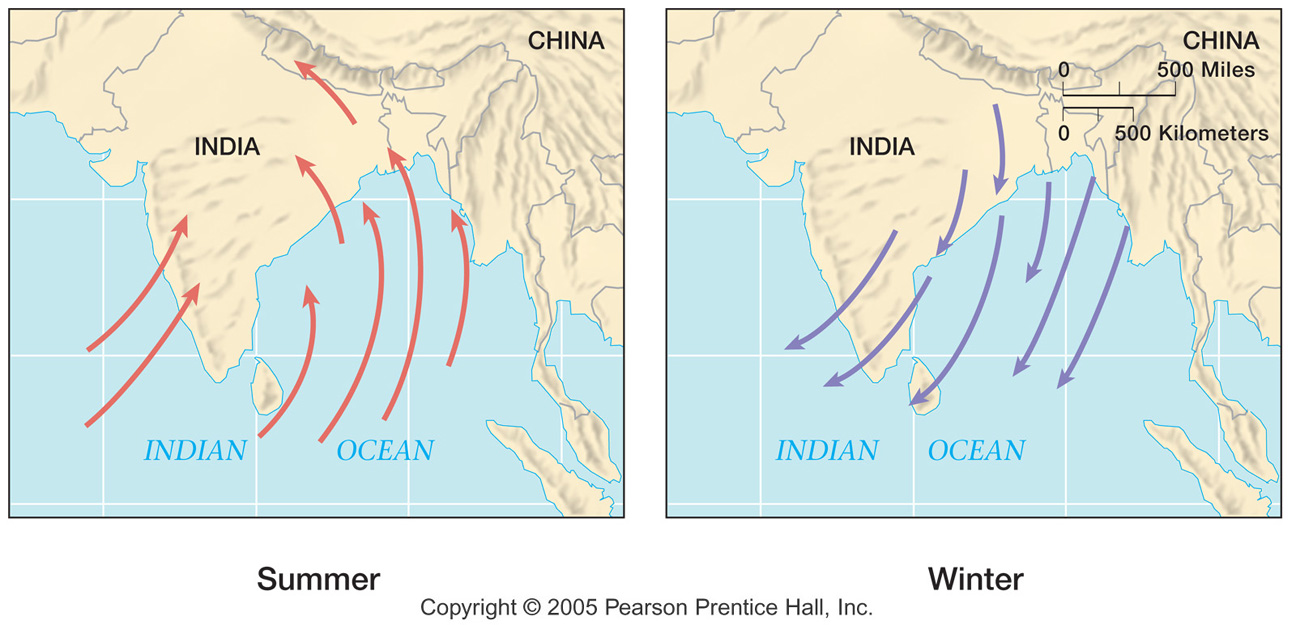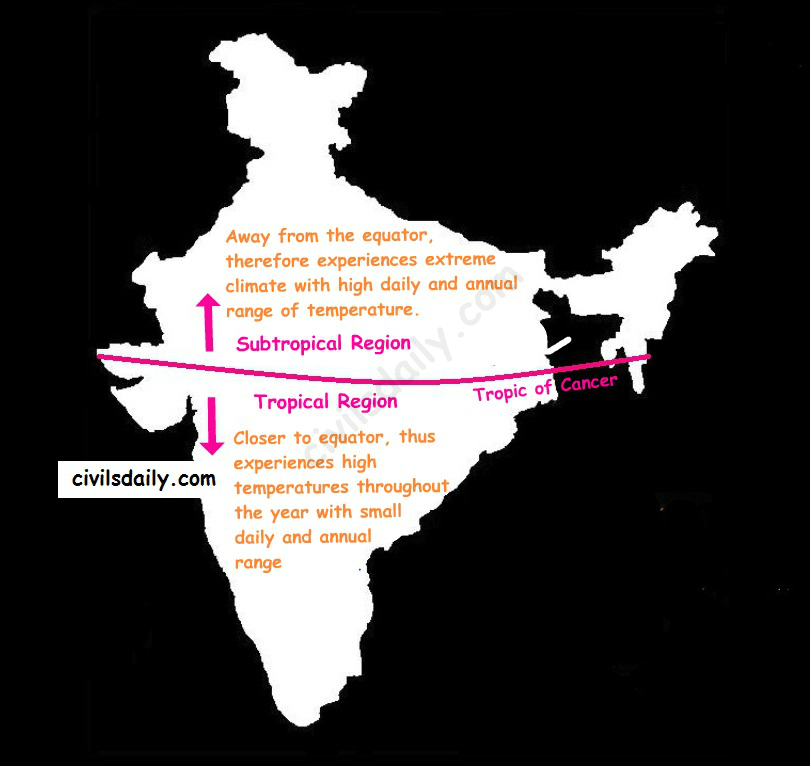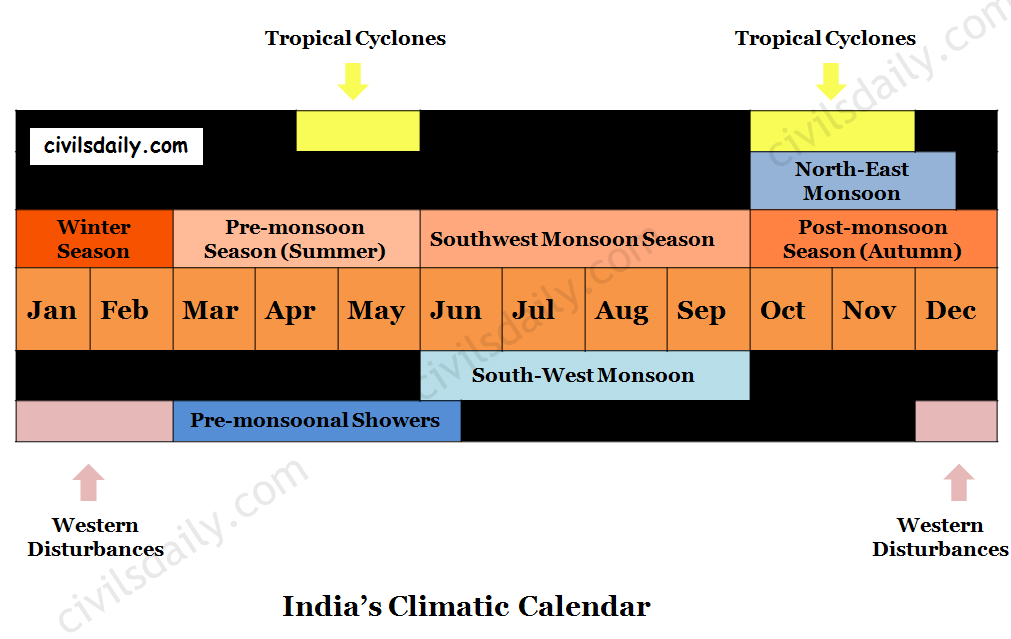- South Asia
- East Asia
- Northern Australia
- West Africa
Let’s take the case of South Asia:
During winter, the large continent of Asia gets extremely cold and the Siberian high pressure develops. Air flow is offshore and dry. During the summer, the continent develops low pressure in response to heating and the airflow reverses. Moisture-laden air from the ocean is brought inland where it rises over the terrain and produces extremely large amounts of rainfall. See the following diagram and observed the marked shift in the wind direction.
 Image Source
Image Source
But at the same time, we know that there are great regional differences and variations experienced in India with respect to temperature rainfall etc. Let’s look at some of these regional variations:
- Variations in temperature: While in the summer the mercury occasionally touches 55°C in the western Rajasthan, it drops down to as low as minus 45°C in winter around Leh. On a December night, the temperature in Drass (Jammu and Kashmir) may drop down to minus 45°C while Thiruvananthapuram or Chennai on the same night record 20°C or 22°C.
- Daily temperature range: In Kerala and in the Andaman Islands, the difference between day and night temperatures may be hardly seven or eight degree Celsius. But in the Thar desert, if the day temperature is around 50°C, at night, it may drop down considerably up to 15°-20°C.
- Regional variations in type and amount of precipitation: While snowfall occurs in the Himalayas, it only rains over the rest of the country. Similarly, while Cherrapunji and Mawsynram in the Khasi Hills of Meghalaya receive rainfall over 1,080 cm in a year, Jaisalmer in Rajasthan rarely gets more than 9 cm of rainfall during the same period. Most parts of the country get rainfall during June-September, but in the coastal areas of Tamil Nadu, it rains in the beginning of the winter season.
These regional variations differentiate the weather and climate of different regions of India.
This brings us to the difference between weather and climate:
Weather is the momentary state of the atmosphere while climate refers to the average of the weather conditions over a longer period of time. Weather changes quickly, maybe within a day or week but climate changes imperceptively and may be noted after 50 years or even more.
Factors Determining the Climate of India:
India’s climate is controlled by a number of factors which can be broadly divided into two groups — factors related to location and relief, and factors related to air pressure and winds.
Factors related to Location and Relief
1. Latitude: The Tropic of Cancer passes through the central part of India in the east-west direction. Thus, the northern part of the India lies in the sub-tropical and temperate zone and the part lying south of the Tropic of Cancer falls in the tropical zone. The tropical zone being nearer to the equator experiences high temperatures throughout the year with small daily and annual range. Areas north of the Tropic of Cancer being away from the equator, experience extreme climate with high daily and annual range of temperature.

1. The Himalayan Mountains:
The lofty Himalayas in the north along with its extensions act as an effective climatic divide.
- The Himalayas act as an invincible shield to protect the subcontinent from the cold northern winds. These cold and chilly winds originate near the Arctic circle and blow across central and eastern Asia.
- The Himalayas also trap the monsoon winds, forcing them to shed their moisture within the subcontinent.
3. Distribution of Land and Water: India is flanked by the Indian Ocean on three sides in the south and girdled by a high and continuous mountain-wall in the north. As compared to the landmass, water heats up or cools down slowly. This differential heating of land and sea creates different air pressure zones in different seasons in and around the Indian subcontinent. The difference in air pressure causes a reversal in the direction of monsoon winds.
4. Distance from the Sea: With a long coastline, large coastal areas have an equable climate. Areas in the interior of India are far away from the moderating influence of the sea. Such areas have extremes of climate. That is why the people of Mumbai and the Konkan coast have hardly any idea of extremes of temperature and the seasonal rhythm of weather. On the other hand, the seasonal contrasts in weather at places in the interior of the country such as Delhi, Kanpur and Amritsar affect the entire sphere of life.
5. Altitude: Temperature decreases with height. Due to thin air, places in the mountains are cooler than places on the plains. For example, Agra and Darjeeling are located on the same latitude, but the temperature of January in Agra is 16°C whereas it is only 4°C in Darjeeling.
6. Relief: The physiography or relief of India also affects the temperature, air pressure, direction and speed of the wind and the amount and distribution of rainfall. The windward sides of Western Ghats and Assam receive high rainfall during June-September whereas the southern plateau remains dry due to its leeward situation along the Western Ghats.
Factors Related to Air Pressure and Wind
The following three factors are responsible for the differences in local climates of India:
-
- Distribution of air pressure and winds on the surface of the earth.
- Upper air circulation caused by factors controlling the global weather and the inflow of different air masses and jet streams.
- The inflow of western cyclones generally known as disturbances during the winter season and tropical depressions during the south-west monsoon period into India.
Note: The variations in the atmospheric pressure closer to the surface of the earth have no role to play in the making of upper air circulation.
The mechanism of these three factors and their impact on the Indian climate will be understood with reference to specific seasons of the year in the following sections.
India’s Climatic Calendar
The climatic conditions of India can best be described in terms of an annual cycle of seasons.
The India Meteorological Department (IMD) recognises the following four seasons:



Please correct the number after latitude it should be 2…. But it was repeated 1